
(University of Michigan, 2013)
Wellsboro, a rural Pennsylvania town of roughly 3,200 residents, wasn’t doing very well economically (Hurdle 2010). Local farms were heavily in debt, motels frequently had occupancy under 40% outside of the tourism season, and many residents earned $12,000 less each year than the state average (Hurdle 2010). All of that started to change in 2008, when farmers started to receive checks of $375,000 or more, catapulting them back into financial solvency (Hurdle 2010). Then the railroad started to pick up, breaking out of more than 20 years of stagnation and doubling its yearly revenue (Hurdle 2010). Following the increase in rail traffic was a similar increase in traffic on the roads, so much so that residents were concerned the roads wouldn’t be able to take it (Hurdle 2010). Motels regularly filled up during the normally quiet winter and other businesses saw a similar increase in customers (Hurdle 2010). What could have caused an economically insignificant town like Wellsboro to experience such a reversal of fortunes? The answer was simple: fracking.
“Fracking”, a common nickname for hydraulic fracturing, is a relatively new form of unconventional gas production (EPA 2017). By injecting a solution of water and various additives into a wellbore at high pressure, surrounding rock formations are fractured, allowing trapped oil or natural gas to escape (EPA 2017, Allen et al., 2013, p. 17768). Once the initial injection is complete, the naturally pressurized gas flows back to the wellbore (EPA 2017). With the gas comes some of the injected fluid, which may now contain naturally occurring materials such as brines, metals, radionuclides, and hydrocarbons (EPA 2017). This returning liquid is known as “flowback”, and is a waste product that is collected for recycling or disposal (EPA 2017). The flowback is contained to prevent the aforementioned materials and some of the methane gas from escaping into the environment (Allen et al., 2013, p. 17769). After the flowback is dealt with, the natural gas escaping from the wellbore can be captured and later sold. Fracking has allowed the extraction of gas from previously inaccessible rock formations such as tight sandstone, shale, and some coal beds (EPA 2017). Wellbores can be vertically drilled hundreds or thousands of feet underground, and can include additional horizontal drillings that extend thousands of feet to help reach the gas dispersed throughout the rock formations (EPA 2017).
Fracking is only a problem insofar as it is an imperfect solution to a larger issue. That larger issue is how to generate energy without further increasing our contribution to climate change. This desire for cleaner fuel sources has made natural gas more attractive, and the increased demand has been met by wider use of fracking. The demand is so great that 91 to 273 additional wells have to be drilled every year just to maintain current production of natural gas (Stephenson et al., 2011, p. 10760). The economic and environmental benefits provided by fracking have been the driving force behind the increased popularity of fracking.
Fracking provides many two main economic benefits: creating jobs and economically producing natural gas. From 2007 to 2012, employment in the U.S. private sector grew by a measly 1%, while the oil and natural gas sector grew by a whopping 40% (U.S. EIA, 2013). This amounted to a total of 725,000 jobs nationwide, cutting unemployment by half a percent during the recession (Reuters, 2015). Most of these jobs were created near where the gas was extracted, at a rate of roughly 2.5 jobs per million dollars of gas extracted (Reuters, 2015). The majority of these jobs were within 100 miles of new natural gas production, with some directly involved in producing the gas, and some indirectly assisting (Reuters, 2015, U.S. EIA, 2013). Jobs for drilling wells increased only marginally, with most of the overall increase being in the areas of extraction and support (U.S. EIA, 2013). As shown by the data, fracking has a significant impact on employment, making it a promising source of energy.
The increased production of natural gas caused by fracking has had many positive economic effects. One of the most stunning effects is that the U.S. now produces 97% of its natural gas needs (U.S. EIA, 2017). This has resulted in net imports of natural gas declining by roughly 3 trillion cubic feet from 2005 to 2016 (U.S. EIA, 2017). In fact, the U.S. is expected to export as much as 7 trillion cubic feet of natural gas per year by 2025 (Sieminski, 2014). For now, the natural gas produced by the U.S. is used domestically, mostly for power generation and in the industrial sector (Sieminski, 2014). This is particularly visible in the Northeastern United States, where electricity generation from natural gas has increased by more than 10 million kWh in Pennsylvania, New York, and New Jersey (U.S. EIA, 2017). With domestic natural gas prices in 2017 being almost universally lower than they were in 2011 (U.S. EIA, 2017), it’s only logical that bulk users of fuel like power plants would switch to take advantage of the sudden windfall. While normally the decrease in operating costs for power plants caused by fracking would be solely of benefit to the economy, this also benefits the environment.
Prices of natural gas in the U.S. are heavily dependent on how much gas can be extracted from shale formations economically (U.S. EIA, 2012). In 2005, near the start of the fracking boom, natural gas prices began to decline rapidly (U.S. EIA, 2012). This trend continued into 2016, with prices plummeting to half of what they were in 2011 (U.S. EIA, 2012). There can be no doubt that fracking is responsible for the current glut of natural gas, with two locations exemplifying this; The Barnett shale in Texas and the Marcellus shale in the Northeast United States. The trends in these areas are mirrored across the U.S., with natural gas from shale and tight formations making up at least 50% of national natural gas production in 2010 (Sieminski, 2014). In Texas horizontal drilling in the Barnett shale has exploded from less than 400 wells in 2004 to over 10,000 by 2010 (U.S. EIA, 2011). These horizontal wells are responsible for roughly 90% of the natural gas production of the entire Barnett shale, despite only making up 70% of productive wells in the region (U.S. EIA, 2011). In the Northeast U.S. the Marcellus shale has provided so much cheap gas that power plants have increased their use of natural gas by 20%, making natural gas responsible for 41% of power generation in the region by 2016 (U.S. EIA, 2017). This has mostly come at the expense of coal, which in New York and Connecticut has seen a 90% decline from 2006 levels (U.S. EIA, 2017). In addition to the increased availability of natural gas, environmental policies such as tax credits and mandates to reduce CO2 emissions have made natural gas increasingly attractive compared to coal (U.S. EIA, 2017). Despite prices in 2012 being 30% lower than the previous year, the only coal that increased in production was high-sulfur coal that is compatible with CO2 reducing scrubbers (U.S. EIA, 2013). Similarly, in 2012 cheap natural gas was so abundant that carbon dioxide emissions from coal burned for power generation decreased to levels not seen since 1984 (U.S. EIA, 2013). While electricity sales declined by only 1% nationally from 2006 to 2016, total CO2 emissions from energy generation fell by roughly 10% (U.S. EIA, 2013, U.S. EIA, 2017). This is due to the fact that the main component of natural gas is methane (CH4) (Teasdale et al., 2014), and methane releases roughly 50% as much carbon as coal when burned (U.S. EIA, 2017). By replacing carbon intensive coal with cleaner natural gas in the energy sector, less total carbon has been emitted despite overall production remaining roughly the same (U.S. EIA, 2013, U.S. EIA, 2017). In 2015 when emissions from coal and natural gas in the energy sector were nearly equal, natural gas produced 80% more electricity than coal, clearly cementing natural gas as the less carbon intense fuel (U.S. EIA, 2017). By providing more energy at a similar or even lesser cost to coal, natural gas is paving the way for an energy-secure future with less carbon emissions.
While natural gas has been shown to cause less carbon dioxide emissions than the coal it is replacing, it brings with it a new problem, that of methane leakage. Methane emissions are a concern because methane is a particularly potent greenhouse gas. Greenhouse gases are gases that trap heat in the atmosphere, contributing to climate change. The overall impact each gas has on global climate change depends on the the amount of time it stays in the atmosphere, overall quantity of it in the atmosphere, and how strongly it absorbs energy (EPA, 2017). Using these factors, greenhouse gases are compared using a unit of measurement known as the Global Warming Potential (GWP) (Forster, 2007., p. 210). GWP is standardized to be comparative to carbon dioxide, so a gas with a GWP of 2 has twice the effects of an identical amount of carbon dioxide when released into the atmosphere (Forster, 2007., p. 210). The GWP of methane is 72 for a period of 20 years, and 21-25 for a period of 100 years (Forster, 2007., p. 212), so we can see it has a much larger impact on trapping heat than carbon dioxide. While methane only has a lifetime of 12 years, the indirect effects it can have on other compounds allow it to do damage long after its initial release (Forster, 2007., p. 212). With natural gas and petroleum systems making up the largest energy-related methane emissions source in the U.S., something needs to be done to control their emissions (EPA, 2017).
For overall emissions coming from fracking, Allen et al. (2013) found that natural gas production emits about 2.3×1012 grams of methane, which comprises of 0.42% of gross gas production (Allen et al., 2013, p. 17772). Of the total emissions, Omara et al. (2016) compared methane emission rates from conventional (vertical drilling for reservoirs that have high permeability) and unconventional (horizontal drilling for low-permeability sources, such as shale) natural gas extraction wells. The authors found that unconventional wells (850 to 9.29×104 g/h) generally emitted higher amounts of CH4 than conventional wells (20 to 4480 kg/h) (Omara et al., 2016, 2102). Considering natural gas’s comparatively massive GWP, total leakage from fracking systems must be less than 3.2% to have net environmental benefits over coal, a notoriously dirty fuel (Alvarez et al., 2012, p. 6437). Consensus in scientific literature shows that fracking in the United States has leakage rates between 3% and 17%, meaning we have likely already passed the point where natural gas provides benefits (Caulton et al., 2015, pg. 6240, Jiang et al., 2011, p. 7, Karion et al., 2013, p. 4396). Coupling the rise in demand of fracking with the rapid decrease of well productivity after the first year (Stephenson et al., 2011, p. 10760), new wells are constantly needing to be drilled. This means methane emissions from fracking will continue to increase, and we will continue to stray further from the environmental benefits fracking was originally thought to have if nothing is done about these emissions (Schneising et al., 2014).
Fracking can be broken into four phases: pre-production, drilling, fracturing, and well completion (Jiang et al., 2011). Of all the stages, well completion has the greatest methane emissions. During this process, methane can be emitted through flowback, the recovery of the liquids, if it is not sent to emission control devices (Allen et al., 2013, p. 17769). Allen et al. (2013) measured a range of about 1.0×104 grams to 1.7×107 grams in methane emissions, with a mean of 1.7×106 grams. Emissions this high should be addressed.
Further compounding the problem is the fact that inventory estimates of methane leaks are almost universally undervalued (Goetz et al., 2015, Caulton et al. 2015). This is partially due to the difficulty of locating the sources of these leaks (Teasdale et al., 2014). Having official estimates of leakage rates chronically lower than actual rates presents a false picture to the public, making continued fracking seem more viable than it may actually be. More than with almost any other energy source, accurately measuring leak rates and continuously working to reduce them is a critical part of making fracking an economically and environmentally viable energy source. Because of these higher emissions, many environmentalists believe fracking should be gotten rid of altogether. However, as mentioned previously, when fracking is done right with technology controlling its methane emissions, it has the potential to be a more environmentally friendly source of energy than coal by emitting less carbon dioxide (U.S. EIA, 2013, U.S. EIA, 2017). This, and the fact that it provides jobs (Reuters, 2015, U.S. EIA, 2013) and lowers the cost of natural gas (U.S. EIA, 2012) is enough reason as to why we should not disregard fracking.
There needs to be solution to fracking’s methane emissions, so that it can meet its potential as an energy source. Allen et al. (2013) measured methane emissions significantly lower than the EPA’s measurements from the national emissions inventory because 67% of the wells that were in the study sent methane to control devices rather than releasing it to the atmosphere, which brought their emissions significantly down (p. 17770). One of the most efficient methods to stop the problem of methane leakage from a fracking site is the vapor recovery unit, better known as VRU. VRUs work with the storage tanks, which store emissions from flowback, on a franking site. Storage tanks on fracking sites without VRUs vent approximately 21 billion cubic feet of gas per year (Harvey, 2012). The storage tanks are used to store the natural gas that has been collected throughout the fracking process. VRUs work to remove methane vapors that build up in the tank. Without VRUs methane can be get lost in the atmosphere when the gas is added to the tank, and when the gas is being removed from the tank (Harvey, 2012). The VRU system works by analyzing the pressure in the tank and when it reaches a set point the gas goes through a gas vent line and into the VRU machine .Within the VRU machine the gas is filtered through a scrubber where the liquid trapped is returned to the liquid pipeline system or to the tanks, and the methane recovered is pumped into gas lines (Changnet, 2008).
VRUs may be the answer to the methane leakage problem, as they can capture up to 95% of methane that would have leaked into the atmosphere from the storage tanks of a fracking site that does not use one (Harvey, 2012). The gas company Encana has a site in Wyoming that installed a VRU in order to reduce methane emissions. The VRU machine has shown to reduce 80% emissions in the past four years (Sider, 2014).
Using this machine will not only reduce most of the methane released, it could also save gas companies thousands of dollars in the long run. The methane gas that is filtered into the VRU can potentially be harvested and used for profit. Anadarko Petroleum Corporation reported that at peak capacity their VRU were able to capture 25 million cubic feet of gas per day. At this rate the company was able to make $18,262 off the VRU alone in one year (Harvey, 2012). Gas companies that are using VRU systems have reported that they have been extremely beneficial when it comes to the payback. The gas producing company ConocoPhilips had installed a VRU system onto 9 tank batteries on one of their sites. This in total cost the company $712,500, however it did not take long for that money to be worth the investment. In just four months the VRU were able to bring the company enough profit to refund this payment. After that every month the VRU brought the company $189,000 (Harvey, 2012).
In 1970, Congress passed the Clean Air Act of 1970, which mandates reductions in various harmful volatile organic compounds (VOC). The act covers many aspects of VOC emissions, but fracking sites continue to emit methane which is harmful to the environment. This brings us to our proposal. If the EPA implemented stricter regulations on methane emissions in the Clean Air Act, companies would be forced to adopt various technologies, VRUs being one of them, in order to meet EPA regulations. In turn, the nation could stay away from relying on coal while minimizing harm to the environment from fracking. Methane emissions from fracking are indeed an issue, and something needs to be done to reduce them.
Certain drilling sites in Montana, Colorado, and Utah have already adopted this technology (EPA, 2014). This is the result of competition between fracking companies who aim to make their sites less harmful to air quality (Biello, 2010). In fact, mandatory Stage I and Stage II vapor recovery systems are a direct result of the Clean Air Act. These systems can be found at gasoline dispensing facilities (GDF), known to all of us simply as the gas stations that dot various roadways. Whenever gasoline is transported or pumped from one container to another, VOCs naturally escape into the atmosphere. Since GDFs can be found in many locations, harmful amounts of VOCs can be emitted into the atmosphere due to the frequency of oil tankers delivering fuel to GDFs and consumers refueling their automobiles. Stage I vapor recovery systems refer to when oil tankers deliver gasoline to various GDFs, and Stage II refers to when consumers refuel their automobiles. When consumers refuel their automobiles at GDFs, VOCs that would normally escape into the atmosphere are returned to the underground gas reservoirs at these GDFs. When oil tankers refill these reservoirs, the trapped VOCs are returned to the oil tankers (PEI, 2017). These regulations have invariably had an incredible impact on VOC emissions in the following years. The EPA shows that since 1970, VOC emissions have dropped from approximately 12 grams per vehicle mile travelled, to 2 (EPA, 2017). This shows that on a federal level, technology can be successfully and widely adopted in order to improve air quality at the expense of energy companies. If it can be done for petroleum, why can’t it be done for natural gas?
In order to reduce humanity’s impact on climate change, we should take the necessary steps to reduce GHG emissions. While hydraulic fracturing is not the largest source of methane emissions, any chance to reduce emissions should be taken advantage of. There are a wide variety of ways one could reduce emissions from fracking, but not all of them are realistic. Flaring is already a common practice in the industry, but why burn off a useful gas when you can harness its potential? When a solution such as VRUs is readily available, why not utilize it? They have a high efficiency of reducing emissions, and provide an opportunity for companies to profit from the captured methane. We see VRUs already being implemented at certain sites across the country, and government-mandated implementation of vapor recovery technology is already present in gas stations, so it seems reasonable to do the same for fracking sites. And with the ever growing need for energy in our industry-driven world, and a steadily decreasing amount of natural gas, shouldn’t we harness all that we can, and protect our world while we’re at it?
AUTHORS
Hillary Wilcox – Animal Science Major
Mikhaela Flynn- Environmental Science Major
Sean Mulvaney – Natural Resource Conservation Major
Winsten Chen- Natural Resource Conservation Major
REFERENCES
Allen, D. T., Torres, V. M., Thomas, J., Sullivan, D. W., Harrison, M., Hendler, A., … Seinfeld, J. H. (2013). Measurements of methane emissions at natural gas production sites in the united states. Proceedings of the National Academy of Sciences of the United States of America, 110(44), 17768-17773. doi:10.1073/pnas.1304880110
Alvarez, R. A., Pacala, S. W., Winebrake, J. J., Chameides, W. L., & Hamburg, S. P. (2012).
Greater focus needed on methane leakage from natural gas infrastructure. Proceedings of
the National Academy of Sciences, 109(17), 6435-6440.
Biello, D. (2010, March 30). What the Frack? Natural Gas from Subterranean Shale Promises U.S. Energy Independence–With Environmental Costs. Retrieved December 3, 2017, from https://www.scientificamerican.com/article/shale-gas-and-hydraulic-fracturing/
Caulton, D. R., Shepson, P. B., Santoro, R. L., Sparks, J. P., Howarth, R. W., Ingraffea, A. R.,
… Miller, B. R. (2014). Toward a better understanding and quantification of methane
emissions from shale gas development. Proceedings of the National Academy of
Sciences, 111(17), 6237-6242. www.pnas.org/cgi/doi/10.1073/pnas.1316546111
[Changet]. (2008, August 2008). Vapor recovery unit principles – sample [Video File] Retrieved from https://www.youtube.com/watch?v=tLBBQtu4l3E
Forster, P., Ramaswamy, V., Artaxo, P., Berntsen, T., Betts, R., Fahey, D. W., … Van Dorland, R. 2007: Changes in Atmospheric Constituents and in Radiative Forcing. In: Climate Change 2007: The Physical Science Basis. Contribution of Working Group I to the Fourth Assessment Report of the Intergovernmental Panel on Climate Change [Solomon, S., D. Qin, M. Manning, Z. Chen, M. Marquis, K.B. Averyt, M.Tignor and H.L. Miller (eds.)]. Cambridge University Press, Cambridge, United Kingdom and New York, NY, USA.
Goetz, J. D., Floerchinger, C., Fortner, E. C., Wormhoudt, J., Massoli, P., Knighton, W. B., et al. (2015). Atmospheric emission characterization of marcellus shale natural gas development sites. Environmental Science & Technology, 49(11), 7012. Retrieved from MEDLINE database. Retrieved from http://www-ncbi-nlm-nih-gov.silk.library.umass.edu/pubmed/25897974
Harvey, S. (2012, March). Leaking profits the US oil and gas industry can reduce, pollution, conserve water, and make money by preventing methane waste, Retrieved November 13, 2017 from https://www.nrdc.org/sites/default/files/Leaking-Profits-Report.pdf
Hurdle, J. (2010, April 05). Natural gas boom brings riches to a rural town. Retrieved December 02, 2017, from https://www.reuters.com/article/us-energy-fracking-wellsboro/natural-gas-boom-brings-riches-to-a-rural-town-idUSTRE6341Y420100405
Jiang, M., Griffin, W. M., Hendrickson, C., Jaramillo, P., VanBriesen, J., & Venkatesh, A. (2011). Life cycle greenhouse gas emissions of Marcellus shale gas. Environmental Research Letters, 6(3), 1-9. doi:10.1088/1748-9326/6/3/034014
Karion, A., Sweeney, C., Pétron, G., Frost, G., Michael Hardesty, R., Kofler, J., … Brewer, A. (2013). Methane emissions estimate from airborne measurements over a western United States natural gas field. Geophysical Research Letters, 40(16), 4393-4397. doi: 10.1002/grl.50811
Omara, M., Sullivan, M. R., Xiang, L., Subramanian, R., Robinson, A. L., & Presto, A. A. (2016). Methane Emissions from Conventional and Unconventional Natural Gas Production Sites in the Marcellus Shale Basin. Environmental Science & Technology, 50(4), 2099-2107. doi:10.1021/acs.est.5b05503
PEI. (2017). Stage II Vapor Recovery. Retrieved December 3, 2017, from https://www.pei.org/wiki/stage-ii-vapor-recovery
Purdue University (2004). Petroleum and Coal. Retrieved November 18, 2017, from
http://chemed.chem.purdue.edu/genchem/topicreview/bp/1organic/coal.html
Reuters. (2015, November 06). U.S. fracking boom added 725,000 jobs -study. Retrieved December 02, 2017, from https://www.reuters.com/article/usa-fracking-employment-study/u-s-fracking-boom-added-725000-jobs-study-idUSL8N13159X20151106
Schneising, O., Burrows, J. P., Dickerson, R. R., Buchwitz, M., Reuter, M., & Bovensmann, H.
(2014). Remote sensing of fugitive methane emissions from oil and gas production in
north american tight geologic formations. Earth’s Future, 2(10), 548-558.
doi:10.1002/2014EF000265
Sider, A. (2014, May 18). Energy Companies Try New Methods to Address Fracking Complaints. Retrieved December 01, 2017.
Sieminski, A. (2014, October 17). Https://www.eia.gov/pressroom/presentations/sieminski_10172014.pdf [PDF]. Chicago: U.S. EIA.
Stephenson, T., Valle, J. E., & Riera-Palou, X. (2011). Modeling the relative GHG emissions of conventional and shale gas production. Environmental science & technology, 45(24), 10757-10764.
Teasdale, C. J., Hall, J. A., Martin, J. P., & Manning, D. A. C. (2014). Ground
gas monitoring: implications for hydraulic fracturing and CO2 storage. ACS Publications,
48, 13610?13616. dx.doi.org/10.1021/es502528c
U.S. EIA. (2011, July 12). Technology drives natural gas production growth from shale gas formations. Retrieved December 03, 2017, from https://www.eia.gov/todayinenergy/detail.php?id=2170
U.S. EIA. (2012, August 27). Projected natural gas prices depend on shale gas resource economics. Retrieved December 03, 2017, from https://www.eia.gov/todayinenergy/detail.php?id=7710
U.S. EIA. (2013, April 5). Energy-related carbon dioxide emissions declined in 2012. Retrieved
November 20, 2017, from https://www.eia.gov/todayinenergy/detail.php?id=10691
U.S. EIA. (2013, August 8). Oil and gas industry employment growing much faster than total private sector employment. Retrieved December 02, 2017, from https://www.eia.gov/todayinenergy/detail.php?id=12451
U.S. EIA. (2013, January 14). 2012 Brief: Coal prices and production in most basins down in 2012. Retrieved December 03, 2017, from https://www.eia.gov/todayinenergy/detail.php?id=9570
U.S. EIA. (2017, June 8). Frequently Asked Questions – How much carbon dioxide is produced
when different fuels are burned? Retrieved November 20, 2017, from
https://www.eia.gov/tools/faqs/faq.php?id=73&t=11
U.S. EIA. (2017, November 13). CO2 emissions from coal fell by record amount in 2015, led by Texas and Midwest. Retrieved December 03, 2017, from https://www.eia.gov/todayinenergy/detail.php?id=33712
U.S. EIA . (2017, May 11). Natural gas has displaced coal in the Northeast’s generation mix over the past 10 years. Retrieved November 20, 2017, from https://www.eia.gov/todayinenergy/detail.php?id=31172
U.S. EIA. (2017, October 25). Where Our Natural Gas Comes From. Retrieved December 02, 2017, from https://www.eia.gov/energyexplained/index.cfm?page=natural_gas_where
U.S. EIA. (2017, October 31). Natural Gas Prices. Retrieved November 20, 2017, from
https://www.eia.gov/dnav/ng/ng_pri_sum_a_EPG0_PEU_DMcf_a.htm
U.S. EPA. (2014). Use of Vapor Recovery Towers and VRU’s to Reduce Emissions. Retrieved December 3, 2017, from https://www.epa.gov/sites/production/files/2016-04/documents/vapor_recovery_units.pdf
U.S. EPA. (2017, April 14). Overview of Greenhouse Gases. Retrieved
from https://www.epa.gov/ghgemissions/overview-greenhouse-gases
U.S. EPA. (2017, January 09). The Process of Hydraulic Fracturing. Retrieved December 02, 2017, from https://www.epa.gov/hydraulicfracturing/process-hydraulic-fracturing
U.S. EPA. (2017). Progress Cleaning the Air and Improving People’s Health. Retrieved December 3, 2017, from https://www.epa.gov/clean-air-act-overview/progress-cleaning-air-and-improving-peoples-health


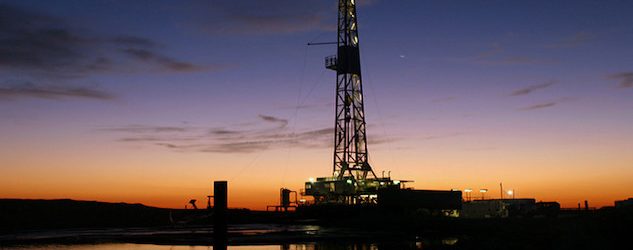

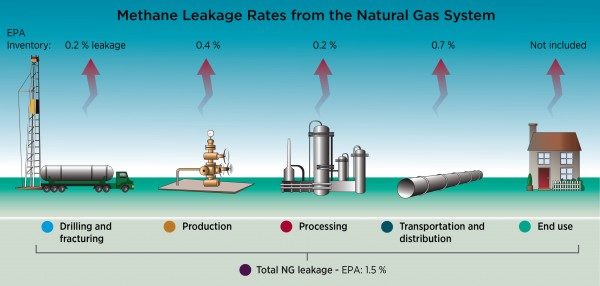

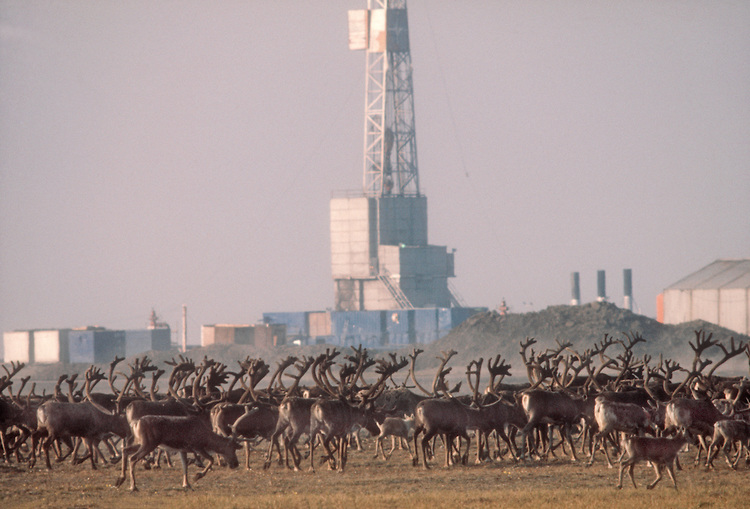

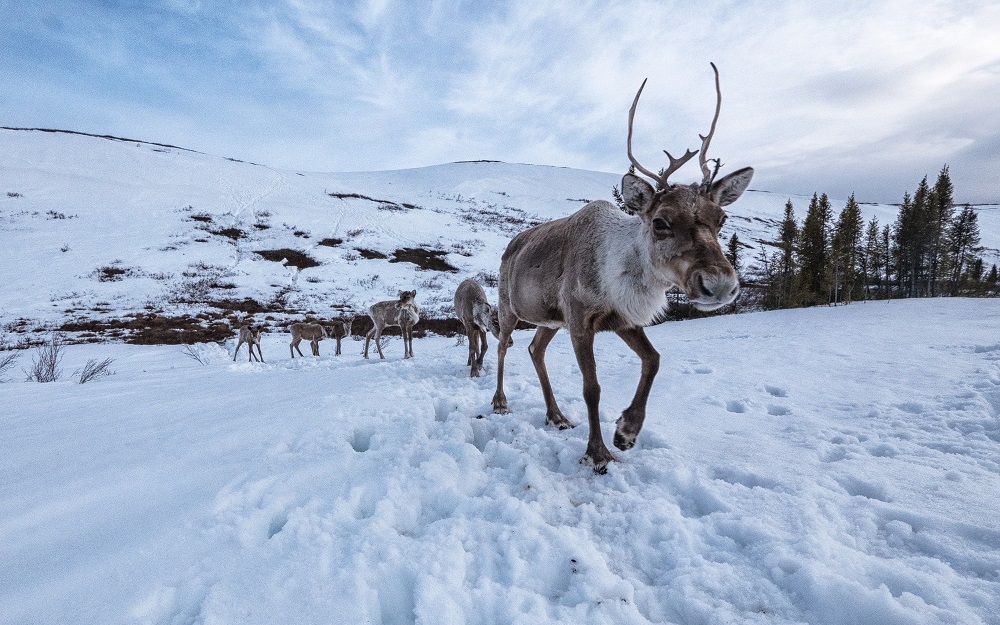
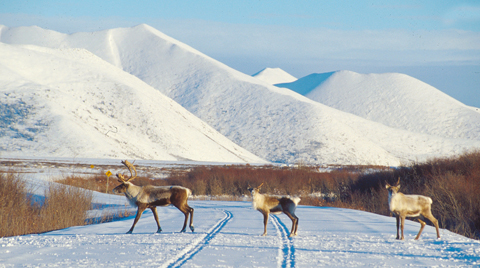

 Every year in April, there is a herd of nearly 197,000 caribou that travel more than 400 miles to reach the plain on Alaska’s northernmost coast. This massive herd is known as the Porcupine Caribou herd and for several months of the year, this Alaskan coastal plain will be their home. It is where the females give birth every June and where the young spend the first weeks of their lives. This area is known as the Arctic National Wildlife Refuge (ANWR) and it provides vital habitat for the Porcupine herd every spring and summer as the place where they can safely birth their calves and begin to raise them (U.S. Fish and Wildlife Service, 2016).
Every year in April, there is a herd of nearly 197,000 caribou that travel more than 400 miles to reach the plain on Alaska’s northernmost coast. This massive herd is known as the Porcupine Caribou herd and for several months of the year, this Alaskan coastal plain will be their home. It is where the females give birth every June and where the young spend the first weeks of their lives. This area is known as the Arctic National Wildlife Refuge (ANWR) and it provides vital habitat for the Porcupine herd every spring and summer as the place where they can safely birth their calves and begin to raise them (U.S. Fish and Wildlife Service, 2016). 










